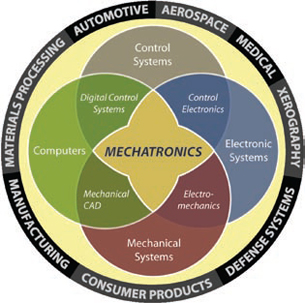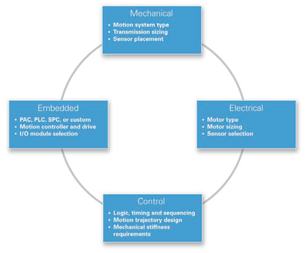Mechatronics Primer: Reinventing Machine Design, 1 in a Series
Today's mechatronic methodology is a reflection of -- and an adaptation to -- changes that have transformed modern machines, enabling the quintessential synergy required to compete.
Latest News
February 2, 2009
By Tom Kevan
Page 1 | 2 »
The one constant in technology in general and design engineering specifically is change. Some changes, however, are bigger than others. One of the largest and most recent involves mechatronics, an evolving concept in machine design that brings best practices, enabling technologies, and the machines themselves, into alignment. At this convergence, the nature of these elements reflects the integration and synergy that typifies engineering today. And, like all major transitions, it’s mandatory.
 Figure 1: Machine builders are designing increasingly complex systems that incorporate a growing range of technologies. To optimize the performance of these machines, designers must adopt mechatronic practices. Without using the new methodology, machine builders will find it more difficult to compete. Image courtesy of National Instruments |
Today’s Machines, Tomorrow’s Design
Today’s machines aren’t what they used to be — they’re more capable and complex. They have evolved from rigid, single-purpose devices based on mechanical gears and cams to flexible, multipurpose machines that incorporate sensors, actuators, embedded software, and servomotors (see Figure 1). The metamorphosis is marked by a shift from purely mechanical devices to electro-mechanical collections of interconnected subsystems, whose functionality is defined by interdependencies that blur the boundaries separating the mechanical, electrical, and software domains.
To meet the challenges posed by the complex amalgam of technologies incorporated in modern machinery, as well as to shorten development times and reduce design risks and costs, the engineering community has moved to improve and streamline the design process. The new methodology called mechatronics requires engineers to assume a multidisciplinary, system-level approach and redefine best development practices.
 Figure 2: Mechatronic design embodies the synergistic integration of traditional mechanical and cutting-edge electronic, computer, and control engineering disciplines, serving a broad swath of industries and enabling the development of flexible multidimensionalsystems. Image courtesy of Kevin C. Craig, Marquette U. |
According to Kevin C. Craig, the Robert C. Greenheck chair in engineering design and professor of mechanical engineering at Marquette University, “Mechatronics is the synergistic integration of physical systems, electronics, controls, and computers through the design process, from the very start of the design process, thus enabling complex decision making.” (see Figure 2)
This concept is by no means static. “The definition of mechatronics itself is evolutionary,” says Masayoshi Tomizuka, professor of mechanical engineering at the University of California, Berkeley. “In the beginning, people tended to give it a very narrow meaning — an electro-mechanical type of coupling. But it’s much more than that. It’s not just electronics and mechanical parts. Mechatronics is more of a design methodology.”
Change Is Mandatory
Evolution not only describes the conceptualization of the methodology but also its adoption. Implementation throughout the industry is uneven because the transition is so great. Engineers must redefine the culture in which they work and the design process they follow before mechatronic design can become standard operating procedure.
The traditional design process conforms to a system of silos that represent individual engineering disciplines (e.g., mechanical and electrical). Designs are passed sequentially from one discipline to another, with little or no communication or interaction among disciplines, until the project is completed. This sequential, compartmentalized approach creates a number of problems and limitations.
“By dividing up the workflow in the sequential way, problems often come up because design decisions are made early in the process that then bind the hands of the engineers later in the process,” says Brian MacCleery, senior product manager for industrial and embedded design at National Instruments. “When you take a sequential approach, it’s too late in many cases to optimize your design. So you end up doing major fixes, but those are just for the showstoppers. The end design doesn’t end up optimized. The best you can hope for is that it works pretty reliably and you can ship it out the door because there’s not a lot of room for optimization in that kind of process. Each part of the engineering design is being held captive by the other ones that came before or after.”
 Figure 3: The mechatronic design process calls for greatly enhanced communications and collaboration among engineering disciplines and heightened awareness of technologicalinterdependencies that affect efforts to optimize machine performance. Image courtesy of National Instruments |
A Demand for Horizontal Integration
Mechatronics approaches the development process differently by requiring a concurrent, or parallel, workflow. In this way, all design decisions are linked. The process allows the design team to identify interdependencies among engineering domains as early as possible in the design and frees individual domain experts to contribute within the context of a holistic viewpoint.
“Mechatronics demands horizontal integration among the various engineering disciplines, as well as vertical integration between design and manufacturing,” says Marquette’s Craig. “No matter what your area of expertise, you have to follow this multidisciplinary systems approach. It is the best practice for synthesis by engineers driven by the needs of industry.”
“Because design changes by any group can have a ripple effect, conducting a more parallel development process augmented by new simulation technologies can yield a more optimized design and help identify flaws earlier in the development process,” says NI’s MacCleery.
Mechatronics demands a major shift in how engineers are trained, how they work together, the tools they use, and what design perspectives they cultivate. After these major changes occur, design teams must then follow a set of well-defined best practices.
Page 1 | 2 »
Subscribe to our FREE magazine, FREE email newsletters or both!
Latest News
About the Author
DE’s editors contribute news and new product announcements to Digital Engineering.
Press releases may be sent to them via [email protected].






